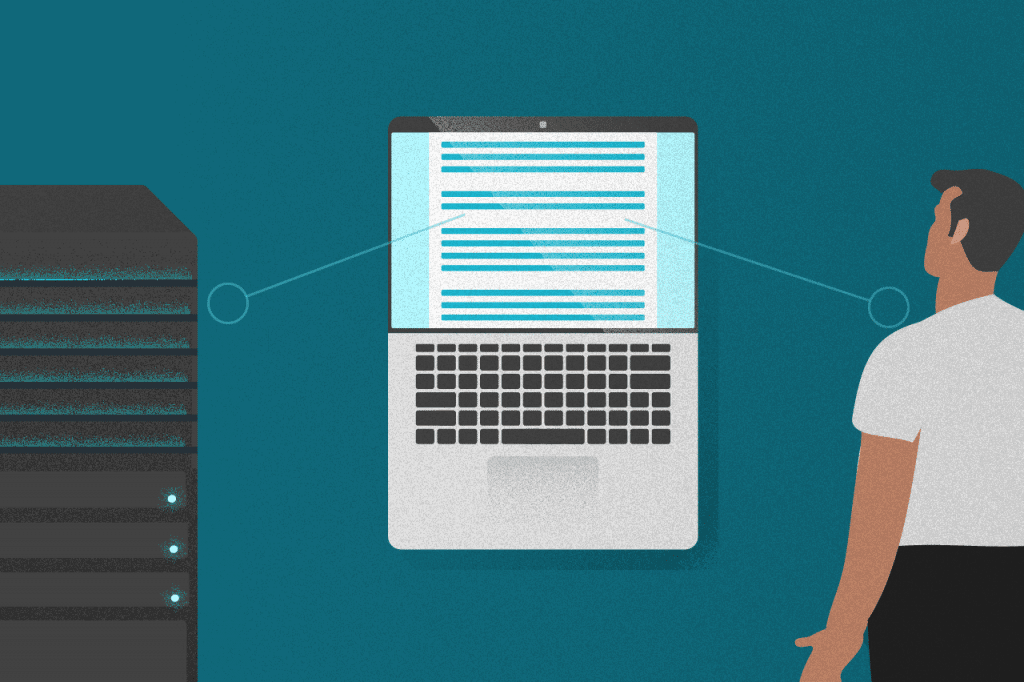When a user accesses a web page, a process starts, so the content is shown on the screen. The request’s response is completed only after processing the command, which allows delivering a page capable of receiving interactions. Who programs this is the web designer and he should always make the following comparison: Client-Side Rendering vs Server-Side Rendering.
These two ways of loading a page have important differences. There are different pros and cons involved in each mode. There is no rule on which mode should be used, so it is important to make a detailed analysis to make the correct choice.
In this post, we will make a comparison between Client-Side Rendering and Server-Side Rendering. The content will cover the following topics:
- What is Client-Side Rendering?
- What is Server-Side Rendering?
- What is the importance of Client-Side Rendering or Server-Side Rendering for SEO?
- What are the pros and cons in choosing Client-Side Rendering?
- What are the pros and cons in choosing Server-Side Rendering?
- Client-Side Rendering vs Server-Side Rendering: which should you use?
Keep reading to understand!
Download this post by entering your email below
What is Client-Side Rendering?
Client-Side Rendering (CSR) is a rendering mode where the request to access a page is processed by the browser, using only the JavaScript file to generate the HTML content.
The access command information is sent to the server, which returns with a simple HTML containing the JavaScript information that will load the entire site.
This is a much more modern rendering method since there is no receiving of an entire HTML page. From a technical point of view, this loading mode makes the process more quickly, requiring less from the server and the browser.
The CSR method is always an option, but it is always important to evaluate the pros and cons, which we will still do in this content.
Check out an illustration of GBK Soft company about how the Client Side Rendering process happens:

What is Server-Side Rendering?
The Server-Side Rendering (SSR) mode is a method considered older and heavier than CSR. Here, when a user accesses a website, this request’s information is sent directly to the server, which responds with a file with the complete HTML code. From this content, the website will be properly loaded in full.
In this method, the server creates a page from the HTML code and the user’s access data who is accessing the site. SSR has spent a lot of time being the most common way to render pages, but analysis and discussions about which method is the best have questioned the use of this technique.
See how this process is illustrated:

What is the importance of Client-Side Rendering or Server-Side Rendering for SEO?
Another comparison needs to be made: Client-Side Rendering vs Server-Side Rendering on SEO. The way web pages are loaded directly impacts the ranking of sites. This is because Google’s algorithms are always looking to detect which pages offer the best user experience.
When a site takes too long to load or has difficulty showing part of its content, there is a drop in the experience. To avoid this, Google programs its algorithms to better rank websites that can prevent these problems. The important point of this issue is: rendering is essential to generate a successful experience.
It is important to note that the choice between CSR and SSR affects how a website will be accessed and, consequently, how it will be within Google’s parameters. Therefore, it is important to emphasize a crucial issue: most of the sites rendered in SSR are optimized to be more easily found on Google.
Because this method is the most traditional and considered the standard, it has a better SEO performance. Therefore, when choosing a rendering method, web designers need to understand which SSR pages have an advantage over CSR when we talk about optimization for better ranking.
What are the pros and cons in choosing Client-Side Rendering?
When analyzing the Client Side Rendering vs Server-Side Rendering comparison, it is necessary to address each’s pros and cons. A choice based on extensive information avoids errors that can impair the performance of a site. First, let’s check which are the main pros in favor of Client-Side Rendering.
Pros
CSR is the most agile rendering process. The response offering a website ready for interaction is much faster when there is no need to load a complete HTML page. In this case, it is enough to perform the processing through a JavaScript file.
Another important advantage is the server usage level. CSR is much lower, precisely because you don’t have to deal with extensive HTML. Thus, more power is available to load the user’s next requests, making the experience better.
Finally, this is considered the best choice in web application development. In general, CSR makes the navigation agile and makes the experience practically flawless.
Cons
We need to talk about bad performance in search engines. Because it is based on JavaScript, CSR can get in the way of website ranking, as Google faces difficulties finding it.
The way CSR rendering is done can generate a slow loading the first time the site is accessed. It’s a one-time behavior, but it can generate a bad first perception about the page.
What are the pros and cons in choosing Server-Side Rendering?
It is also essential to analyze which are the pros and cons of Server-Side Rendering. Despite being a method considered older, SSR has qualities that deserve to be highlighted. Watching them carefully ensures the web designer the knowledge to make an accurate choice. Check out the main aspects of this method below.
Pros
Search engine optimization. Without a doubt, this is the main advantage when choosing SSR. Pages that use this rendering method drive much more traffic and are positioned better in Google Ranking. Still, the company reinforces that there is no favoring of SSR, even with frequent users’ complaints.
Also, about SEO, another important advantage in SSR is the faster indexing of pages. This means that the algorithms detect the content and rank it in less time.
As for loading the page, access is fast for the first time since the HTML file offered by the server is complete. This wealth of data and information makes the rendering process very agile.
Cons
No matter how fast the first access is in SSR, the rest of the experience may be affected. Each time the user accesses another page within the website, a new HTML file is loaded. This generates a large use of the server, which accumulates information of all user activity.
This typical SSR behavior also generates higher cache retention, with more complex information to be processed. Once again, the server is affected, slowing down the browsing experience and causing a higher latency in communication with the browser.
The consequence of this higher server demand is hiring a more robust hosting service, which has a higher cost. The cost-benefit ratio tends to get worse when the choice is SSR.
Client-Side Rendering vs Server-Side Rendering: which should you use?
After checking more information about Client Side Rendering vs Server-Side Rendering pros and cons, you must surely be thinking that it is time to finally make a decision.
The choice, however, is not as easy as it seems. No matter how important it is to evaluate each one’s advantages and disadvantages, it is essential to analyze individual projects and their characteristics.
For example, an institutional website of a company that is already stabilized in the market and does not need to attract so much traffic doesn’t need to focus as much on optimization. In this case, the choice of CSR could be advantageous.
However, if you need to stand out among your competitors and drive traffic, you can’t deny that SSR might be the best choice.
Among the different options and scenarios, some parameters can help in the decision. Let’s start with CSR, indicating that it can be the right choice when:
- the website is complex, with many resources and pages;
- the application has large data;
- the goal is to have a website with a lot of content and a high volume of simultaneous accesses.
For SSR, this method is more recommended when:
- the application or web site has fewer pages and features;
- the site has few data;
- there are few simultaneous accesses and low traffic, in general.
Client-Side Rendering vs Server-Side Rendering analysis is valuable and should be a valued issue for web designers. Who designs websites is committed to always think of the best for the user, especially in terms of performance. Thus, the results for companies can reach expectations.
Want to know how to have a successful website for your company in WordPress? Check out a guide on the topic!
2024 State of Marketing Report
Your golden ticket to crush your goals with data-driven insights!
2024 State of Marketing Report
Your golden ticket to crush your goals with data-driven insights!

![[Rock NA] State of Marketing Reports 2024 – Comkt Hubspot State of Marketing Report 2024](https://rockcontent.com/wp-content/uploads/2022/07/Banner-Fino-Rock-Convert-2500-%C3%97-500-px-19.png)







